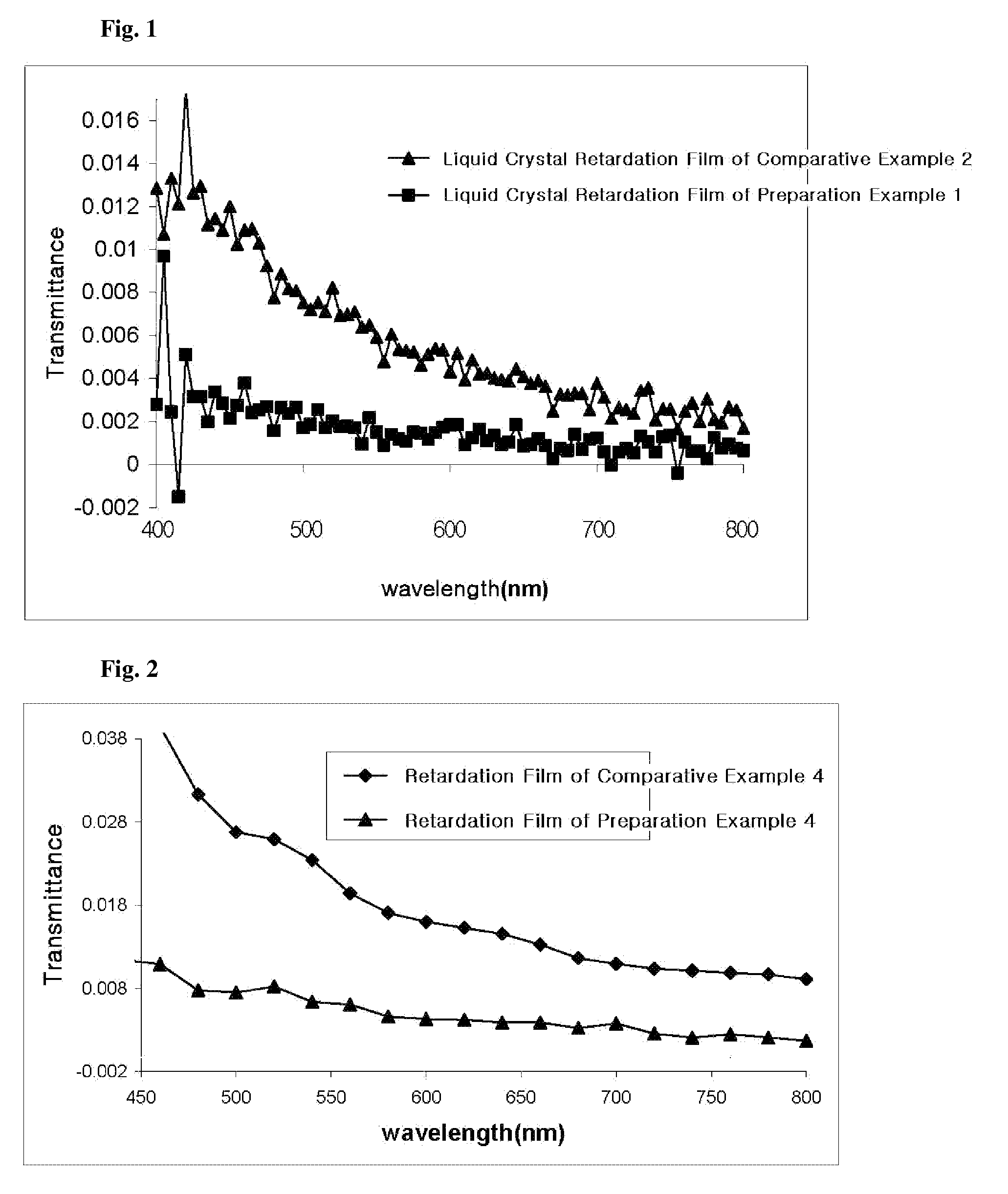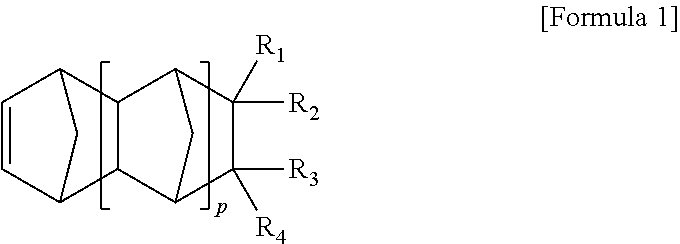Photoreactive polymer and method for preparing the same
a photoreactive polymer and polymer technology, applied in the field of photoreactive polymers, can solve the problems of reduced yield of products, increased preparing cost, and reduced contrast, and achieve excellent thermal stability, slow photoreactive rate, and relatively high mobility of main chains
- Summary
- Abstract
- Description
- Claims
- Application Information
AI Technical Summary
Benefits of technology
Problems solved by technology
Method used
Image
Examples
example 1
Synthesis of 5-norbornene-2-methyl-4′-methoxy cinnamate Ring-Opened Hydrogenated Polymer
(1) Synthesis of 5-norbornene-2-methanol
[0096]DCPD (dicyclopentadiene, Aldrich, 397 g, 3 mol), and aryl alcohol (Aldrich, 331 g, 5.7 mol) were put into the high pressure reactor having the volume of 2 L and then heated to 210° C. The agitation was performed at 300 rpm to conduct the reaction for 1 hour. When the reaction was finished, the reactant was cooled and then moved to the distillation device. The distillation was performed twice under reduced pressure of 1 torr by using the vacuum pump to obtain the product at 56 t (yield: 52%).
[0097]1H-NMR (300 MHz, CDCl3): δ6.17˜5.91 (m, 2H), 3.71˜3.19 (m, 2H), 2.91˜2.75 (m, 2H), 2.38 (m, 1H), 1.83 (m, 1H), 1.60˜1.12 (m, 2H), 0.52 (m, 1H)
(2) The Ring Opening Metathesis Polymerization and the Hydrogenation Reaction of 5-norbornene-2-methanol
[0098]6.20 g (50 mmol) of 5-norbornene-2-methanol that was synthesized in (1) was punt into the Schlenk flask havin...
example 2
Synthesis of the 5-norbornene-2-(4′-hydroxy-4-methoxychalcone)ester Ring-Opened Hydrogenated Polymer
(1) Synthesis of the Ring-Opened Hydrogenated Polymer of the 5-norbornene-2-carboxylic acid
[0102]11.0 g (79.64 mmol) of the 5-norbornene-2-carboxylic acid was put into the Schlenk flask having the volume of 250 ml under an Ar atmosphere, and 55 g of toluene that was purified by using the solvent was added thereto. 18.2 mg (1.6 mmol) of triethyl aluminum (TEA) that was the cocatalyst was first added thereto while the flask was maintained at the polymerization temperature of 80° C. Subsequently, 1.6 ml of the 0.01 M (mol / L) toluene solution (WCl6 0.016 mmol, ethanol 0.048 mmol) in which tungsten hexachloride (WCl6) and ethanol were mixed with each other at a ratio in the range of 1:3 was added to the flask. Finally, 1.34 g of 1-octene (11.95 mmol) that was the molecular weight controlling agent was added to the flask and then reacted at 80° C. for 18 hours while the agitation was perfor...
example 3
Synthesis of the 5-norbornene-2-(7-hydroxy-6-methoxy coumarine)ester Ring-Opened Hydrogenated Polymer
[0105]10.1 g of the ring-opened hydrogenated polymer of the 5-norbornene-2-carboxylic acid that was synthesized in (1) of Example 2 (71.55 mmol), 12.49 g of 7-hydroxy-6-methoxycoumarin (Aldrich, 65.0 mmol), 19.9 g of EDC(N-ethyl-N′-(3-dimethylaminopropyl)carbodiimide hydrochloride) (Aldrich, 104.2 mmol), and 13.2 g of HOBT (1-Hydroxybenzotriazole hydrate) (Aldrich, 97.52 mmol) were sequentially put into the two-neck flask having the volume of 250 ml, and then dissolved in 100 ml of DMF. After the temperature was reduced to 0° C., triethylamine (Aldrich, 45 ml, 325 mmol) was slowly dropped. After the temperature was increased to normal temperature and maintained overnight. When the reaction was finished, the extraction was performed by using a great amount of ethyl acetate. The resulting substance was washed by using NaHCO3 and H2O, the reaction solution was dropped on acetone to perf...
PUM
| Property | Measurement | Unit |
|---|---|---|
| temperature | aaaaa | aaaaa |
| temperature | aaaaa | aaaaa |
| pressure | aaaaa | aaaaa |
Abstract
Description
Claims
Application Information
 Login to View More
Login to View More - R&D
- Intellectual Property
- Life Sciences
- Materials
- Tech Scout
- Unparalleled Data Quality
- Higher Quality Content
- 60% Fewer Hallucinations
Browse by: Latest US Patents, China's latest patents, Technical Efficacy Thesaurus, Application Domain, Technology Topic, Popular Technical Reports.
© 2025 PatSnap. All rights reserved.Legal|Privacy policy|Modern Slavery Act Transparency Statement|Sitemap|About US| Contact US: help@patsnap.com



